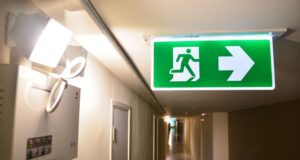What Does the Term “Emergency Lighting” Imply?
Emergency lighting is a term that refers to battery-operated or otherwise self-contained light sources that are meant to activate in the event of a power loss that results in poor visibility in a workplace.
Modern business and residential construction rules necessitate the usage of emergency lights. Numerous building standards also demand the upgrading of older structures with emergency lights.
Emergency lighting is designed to direct personnel toward the building’s exit safely. Depending on the nature of the facility and the possible risks and impediments that may obstruct a worker’s ability to make a safe evacuation, this may entail highlighting the exit or providing low-level illumination throughout the building. In certain professional settings, such as commercial airplanes, floor-level emergency lights may be employed to assist people in finding an exit.
Why is it Necessary to Have Emergency Lighting?
Emergency illumination is a lifesaver in the dangerous scenarios that this intricate background creates. Most importantly, it permits the safe, rapid, and effective evacuation of places and structures, not only in the event of a blackout caused by a power failure but even while sunlight and mains illumination are still accessible.
Additionally, an excellent emergency lighting system directs individuals in and around enclosed and open spaces and assists them in locating safety equipment and refuge and assembly places. Emergency lighting alleviates fear and saves lives by providing critical illumination and directing people to safe areas and safety equipment.
Lighting For Emergency Exits
There are three primary considerations for emergency exit lighting: 1) lighting for escape routes; 2) lighting for open areas / anti-panic areas; and 3) lighting for high-risk job areas.
- Escape route lighting is a component of an emergency lighting system that illuminates a building’s escape routes, such as stairwells and corridors, as well as the location of firefighting equipment, such as fire extinguishers, and safety/security equipment, such as key boxes containing emergency keys to exit doors. As such, escape route illumination may be seen as a basic necessity of fire safety in all non-domestic buildings and public areas of HMOs, regardless of their usage or occupancy level.
- Large public buildings, such as retail malls, museums, and exhibition halls, draw many unfamiliar people with the layout. As a result, panic may develop if the blaring of a fire alarm prompts an emergency evacuation. In such instances, open area / anti-panic lighting is critical to identifying escape routes and exits and directing people towards them.
- High-risk task lighting is a subset of emergency lighting that is used to guarantee the safety of those engaged in potentially hazardous processes or situations. This form of illumination will only be effective in a restricted number of situations. It must be adequate to allow for the implementation of the required shut-down processes.
The contrasts made above emphasize the critical significance of emergency escape lighting in fire safety and how it is tailored and used on a case-by-case basis to the unique usage and occupancy levels of a given structure and/or location within it.
Where Should Emergency Lighting Be Installed?
When designing your emergency lighting installation, it’s important to keep the following in mind:
- Emergency lighting is often required for commercial, industrial, educational, institutional, religious, and medical buildings.
- All evacuation routes in a facility, including halls, stairwells, and corridors, must be lighted with emergency backup lights to ensure that anybody with normal eyesight can see the exit route.
- Without windows, internal rooms, restrooms, and storage places bigger than a broom closet need emergency illumination.
- Emergency lighting fixtures must be properly placed to avoid extremely brilliant or dark areas.
- Occasionally, exceptions might be allowed for places with wide windows that provide an abundance of natural light.
- Bear in mind that lights must be directed properly to illuminate the path. Bulbs angled toward the ceiling or wall do not comply with code standards, even if appropriately placed.
Looking for Best Emergency Lighting Installations in Abbotsford Area? visit Gregg Electric online or call us at (604) 557-4734 today.



